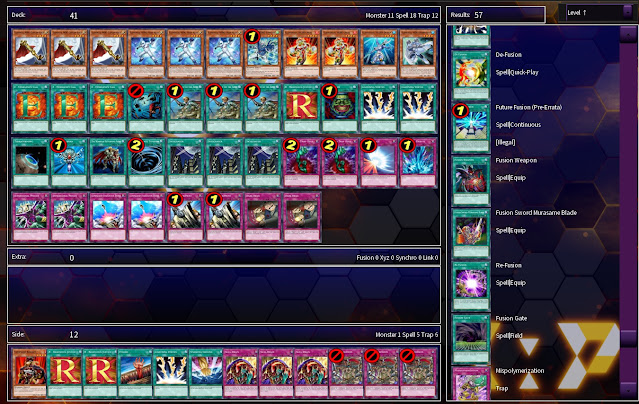This is part of a series of articles on the Yu-Gi-Oh! Trading Card Game, written to assist players participating in the Cup of Greed tournament, hosted by Pod of Greed (the only podcast officially sponsored by KaibaCorp).
This is the second in a three-part series on using EDOPro. It briefly goes over the Deck Editor, as well as some of the settings you might want to change.This is what the deck editor screen looks like. As a general overview: the left pane has the image and text of whatever card you most recently moused over, along with some additional features; the central region contains your Main Deck, Extra Deck below it, and Side Deck below that; the top left has options for choosing your banlist and selecting and modifying your current deck; the top right contains the filters for searching for cards; and the right pane is the card search results.
First, remember to import the "5D's CoG 2023" list, and set that as your banlist. This will give you the right card pool and set of banned cards.
When entering a number (Level, ATK, DEF), you can also use less/greater-than and less/greater-than-or-equal-to symbols. So if I wanted to look at Level 4 or lower monsters, I could enter <=4 or <5. As far as I know, there's no way to search for a range of numbers.
The "Effect" button filters by effect categories: so you can search for all cards with effects that destroy monsters, or all cards that draw, etc. I've never searched this way, so I have no idea how thorough this search method is, or if there are some cards that haven't been categorized properly.
The "Search" filter searches card names and effect boxes for the text you enter. This is not case-sensitive. There are probably some advanced search functions, but the only one I know of is that, if you put an * between two search terms, the asterisk represents an indefinite number of characters, so the search will return anything with those two terms in that order, even if there are words between them. For example, you could search "remov*play" to get all cards that say "remove from play", "removed from play", "removing from play", "remove it from play", etc. Because the search looks for the terms in the given order, searching "dark*tuner" would return Frozen Fitzgerald (1 DARK Tuner + 1 non-Tuner Beast-Type monster), but not Dark End Dragon (1 Tuner + 1 or more non-Tuner DARK monsters).
You can left-click and drag to move cards around. If you right-click a card in the search results, it will be added to the Main Deck (or Extra Deck). Right-click a card in the deck and it will be removed. Middle-click a card in the deck to add another copy.One important thing to note is that EDOPro does not give a shit about your unsaved changes. If you exit the Deck Editor, or even switch the deck you're editing, without having saved first, your changes will disappear without being asked.
When you're satisfied with your deck, you should probably press the "Test Hand" button. This lets you start a duel with no opponent, so you can try out opening hands with your deck and see if you like them.If you want to test your deck against an AI opponent...that's for part three of this series.
To end, let's take a quick look at a couple settings you might want to change. You can access EDOPro's settings from the main menu, by clicking this gear icon. You can also open them at any time by pressing Ctrl+O.Under the "Duel" tab, you have checkboxes for "Automatic Monster Card placement" and "Automatic Spell/Trap Card placement", which by default are unchecked. This has the program automatically choose the zones you place your cards in on the field, instead of having you choose yourself.
When Link Monsters are introduced, the zones you place your cards in will suddenly become very important. This is why EDOPro turns off automatic card placement by default. Prior to Link Monsters, every card simulator, official and unofficial, automatically placed your cards for you.
The tiny number of cards that have to do with card placement are quite bad and not worth worrying about, so you can safely check these options and save a little time.
Also, in the "Sound" tab you can adjust the volume of music and sound effects, as well as mute either of them.
UPDATE: Under the "Client" tab, there is a setting called "UI scale", which adjusts the size of the text and buttons. You may have notice, but by default these are pretty small. I'd suggest upping this to maybe 150%, depending on the size of your screen.







No comments:
Post a Comment